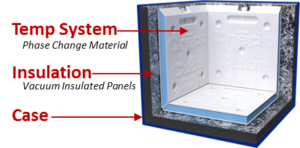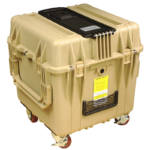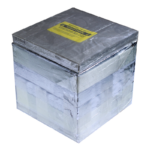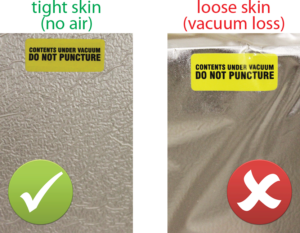Inspecting and Validating a Cool Cube™ PCM Cooler

Ten-year-old Cool Cube™ PCM coolers are still in the field and transporting valuable temperature sensitive material (vaccine, blood, varicella, medicine, platelets, etc.). So with a bit of care and these helpful tips, you too can expect a long life from your Cool Cube™ PCM cooler.

Outer Shell (the bag or case that enables mobility)
Longevity – A lifetime.
Strengths – Durability and features specifically made for transport (straps, wheels, handles, pockets, depending on model).
Weakness – Cleaning can be not-so-fun (as any cleaning is…right?).
Inspecting – Visually check for rips, tears, and/or dirt.
Maintenance – Clean using warm water and soap.
 Cool Cube™ 03 & 08: “Soft-Sided” Bag – The aesthetics of the bag have changed a bit over the years, but the overall concept has not. Made out of a tough, durable nylon, both the older version (tan) and newer version (blue) bags will withstand the rigors of general use for years. Care must be taken when washing, but this piece of the Cool Cube™ is lite and strong. If it does wear out (or you just want a newer bag), this component can be purchased à la carte here.
Cool Cube™ 03 & 08: “Soft-Sided” Bag – The aesthetics of the bag have changed a bit over the years, but the overall concept has not. Made out of a tough, durable nylon, both the older version (tan) and newer version (blue) bags will withstand the rigors of general use for years. Care must be taken when washing, but this piece of the Cool Cube™ is lite and strong. If it does wear out (or you just want a newer bag), this component can be purchased à la carte here.
 Cool Cube™ 28 & 96: “Hard-Sided” Case – These cases (made by Pelican and “built to protect”) are rugged and tough, designed for the cold of the arctic and heat of the desert. After we work our magic on them (Tru-Trac System™, cord port, external pocket, etc.) they are well equipped to provide easy, hassle-free transport. The case itself should outlast any other part of the Cool Cube™ system. But again, if the need arises it can be purchased à la carte here.
Cool Cube™ 28 & 96: “Hard-Sided” Case – These cases (made by Pelican and “built to protect”) are rugged and tough, designed for the cold of the arctic and heat of the desert. After we work our magic on them (Tru-Trac System™, cord port, external pocket, etc.) they are well equipped to provide easy, hassle-free transport. The case itself should outlast any other part of the Cool Cube™ system. But again, if the need arises it can be purchased à la carte here.Temperature Controlling System (the PCM panels)
Longevity – 10,000+ thermal cycles.
Inspecting – Visually check for leaks and/or dirt.
Strengths – Simple design, quality of PCM, and durability.
Weakness – Knowing what size of panels goes in what case (when you have multiple systems).
Maintenance – Clean using warm water and soap. Sanitization can be performed using an isopropyl alcohol and water mixture (typically 70/30) or other salt-based disinfectants. DO NOT: autoclave; expose to extreme heat (above 75°C/167°F); use abrasive cleaners; use acetone (or other similar solvents).
More about the temperature controlling system… All of the various types and sizes of phase change material (PCM) panels have been thoroughly tested (gravity, pressure, freeze/thaw, pull, etc.) to perform for years and years. The PCM itself is very pure, has a strategic melting/freezing point, is safe, non-toxic and reusable. But before panels are filled with quality PCM, they undergo a proprietary sealing process that insures material compatibility (between the PCM and plastic panel) and minimizes permeation (which all plastics exhibit). The result is a less than 0.6% overall loss of PCM over the course of ten years—which has been calculated to NOT significantly impact the performance of a PCM system. If you lose a panel or want to replace a set, they can be purchased à la carte here.
All of the various types and sizes of phase change material (PCM) panels have been thoroughly tested (gravity, pressure, freeze/thaw, pull, etc.) to perform for years and years. The PCM itself is very pure, has a strategic melting/freezing point, is safe, non-toxic and reusable. But before panels are filled with quality PCM, they undergo a proprietary sealing process that insures material compatibility (between the PCM and plastic panel) and minimizes permeation (which all plastics exhibit). The result is a less than 0.6% overall loss of PCM over the course of ten years—which has been calculated to NOT significantly impact the performance of a PCM system. If you lose a panel or want to replace a set, they can be purchased à la carte here.
Insulation (the VIP system)
Longevity – 5+ years.
Inspecting – Visually check for a compromised panel and/or dirt. (Note: the clear polycarbonate is a protective encapsulation that does not affect the VIP performance. If the polycarbonate is compromised [cracked, punctured, or broken], it does not necessarily mean the insulation has been as well. If the VIP still holds a vacuum, taping or altering the polycarbonate is acceptable, as it is only for protection.)
Strengths – The R-value…the best type of insulator AND it’s on all six sides of the cooler.
Weakness – Could be punctured, which would decrease performance.
Maintenance – Handle with care. Clean using warm water and soap. Sanitization can be performed using an isopropyl alcohol and water mixture (typically 70/30) or other salt-based disinfectants. DO NOT: autoclave; expose to extreme heat (above 75°C/167°F); use abrasive cleaners; use acetone (or other similar solvents).
 VeriCor’s Cool Cube™ PCM coolers incorporate the use of high R-value vacuum insulation panel (VIP) assemblies. Cooler specific assemblies are comprised of six individually sealed panels. Each panel is encapsulated in a 5 mil to 10 mil polycarbonate that provides exceptional impact protection (2X that of PVC). After each panel is encapsulated, they get taped together to form the six-sided assembly.
VeriCor’s Cool Cube™ PCM coolers incorporate the use of high R-value vacuum insulation panel (VIP) assemblies. Cooler specific assemblies are comprised of six individually sealed panels. Each panel is encapsulated in a 5 mil to 10 mil polycarbonate that provides exceptional impact protection (2X that of PVC). After each panel is encapsulated, they get taped together to form the six-sided assembly.
-
 Visually check the skin of the panel (white in older models; silver in newer models) as it should be sucked tight to the core creating a rippled, textured surface. If it is, it still has its vacuum and is good. If the skin has a wave or two and appears loose, the panel has been compromised and will not be as effective.
Visually check the skin of the panel (white in older models; silver in newer models) as it should be sucked tight to the core creating a rippled, textured surface. If it is, it still has its vacuum and is good. If the skin has a wave or two and appears loose, the panel has been compromised and will not be as effective.- Touching a panel can also tell a lot. Pushing on a good VIP panel, it will seem very rigid and hard. Pushing on a panel that has lost its vacuum will seem soft and squishy.
Cool Cube™ PCM coolers protect human lives through payload protection, are a sustainable solution in regards to environmental stewardship, and have durable, long-lasting components that drive down the cost per use. Here’s to a long, protective life. 🥂



You must be logged in to post a comment.